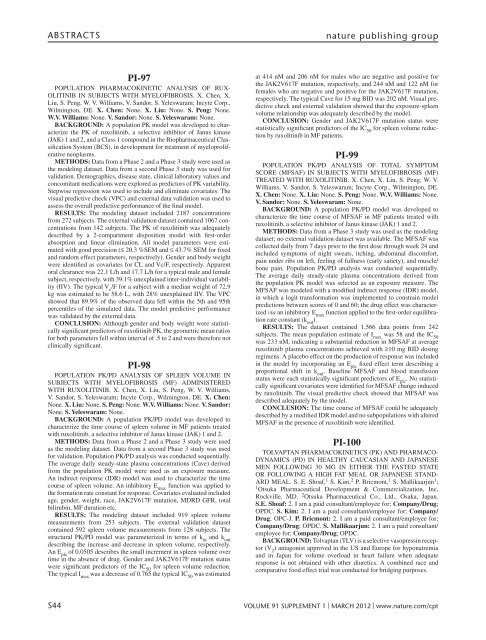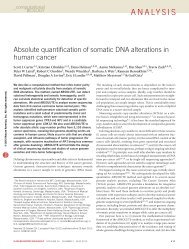Poster Session I (PI 1-106)Displayed 8:00 am – 3:00 ... - Nature
Poster Session I (PI 1-106)Displayed 8:00 am – 3:00 ... - Nature
Poster Session I (PI 1-106)Displayed 8:00 am – 3:00 ... - Nature
Create successful ePaper yourself
Turn your PDF publications into a flip-book with our unique Google optimized e-Paper software.
aBsTraCTs nature publishing group<br />
<strong>PI</strong>-97<br />
POPULATION PHARMACOKINETIC ANALYSIS OF RUX-<br />
OLITINIB IN SUBJECTS WITH MYELOFIBROSIS. X. Chen, X.<br />
Liu, S. Peng, W. V. Willi<strong>am</strong>s, V. Sandor, S. Yeleswar<strong>am</strong>; Incyte Corp.,<br />
Wilmington, DE. X. Chen: None. X. Liu: None. S. Peng: None.<br />
W.V. Willi<strong>am</strong>s: None. V. Sandor: None. S. Yeleswar<strong>am</strong>: None.<br />
BACKGROUND: A population PK model was developed to characterize<br />
the PK of ruxolitinib, a selective inhibitor of Janus kinase<br />
(JAK) 1 and 2, and a Class 1 compound in the Biopharmaceutical Classification<br />
System (BCS), in development for treatment of myeloproliferative<br />
neoplasms.<br />
METHODS: Data from a Phase 2 and a Phase 3 study were used as<br />
the modeling dataset. Data from a second Phase 3 study was used for<br />
validation. Demographics, disease state, clinical laboratory values and<br />
concomitant medications were explored as predictors of PK variability.<br />
Stepwise regression was used to include and eliminate covariates. The<br />
visual predictive check (VPC) and external data validation was used to<br />
assess the overall predictive performance of the final model.<br />
RESULTS: The modeling dataset included 2187 concentrations<br />
from 272 subjects. The external validation dataset contained <strong>106</strong>7 concentrations<br />
from 142 subjects. The PK of ruxolitinib was adequately<br />
described by a 2-compartment disposition model with first-order<br />
absorption and linear elimination. All model par<strong>am</strong>eters were estimated<br />
with good precision (≤ 20.3 %SEM and ≤ 43.7% SEM for fixed<br />
and random effect par<strong>am</strong>eters, respectively). Gender and body weight<br />
were identified as covariates for CL and Vc/F, respectively. Apparent<br />
oral clearance was 22.1 L/h and 17.7 L/h for a typical male and female<br />
subject, respectively, with 39.1% unexplained inter-individual variability<br />
(IIV). The typical V c /F for a subject with a median weight of 72.9<br />
kg was estimated to be 58.6 L, with 28% unexplained IIV. The VPC<br />
showed that 89.9% of the observed data fell within the 5th and 95th<br />
percentiles of the simulated data. The model predictive performance<br />
was validated by the external data.<br />
CONCLUSION: Although gender and body weight were statistically<br />
significant predictors of ruxolitinib PK, the geometric mean ratios<br />
for both par<strong>am</strong>eters fell within interval of .5 to 2 and were therefore not<br />
clinically significant.<br />
<strong>PI</strong>-98<br />
POPULATION PK/PD ANALYSIS OF SPLEEN VOLUME IN<br />
SUBJECTS WITH MYELOFIBROSIS (MF) ADMINISTERED<br />
WITH RUXOLITINIB. X. Chen, X. Liu, S. Peng, W. V. Willi<strong>am</strong>s,<br />
V. Sandor, S. Yeleswar<strong>am</strong>; Incyte Corp., Wilmington, DE. X. Chen:<br />
None. X. Liu: None. S. Peng: None. W.V. Willi<strong>am</strong>s: None. V. Sandor:<br />
None. S. Yeleswar<strong>am</strong>: None.<br />
BACKGROUND: A population PK/PD model was developed to<br />
characterize the time course of spleen volume in MF patients treated<br />
with ruxolitinib, a selective inhibitor of Janus kinase (JAK) 1 and 2.<br />
METHODS: Data from a Phase 2 and a Phase 3 study were used<br />
as the modeling dataset. Data from a second Phase 3 study was used<br />
for validation. Population PK/PD analysis was conducted sequentially.<br />
The average daily steady-state plasma concentrations (Cave) derived<br />
from the population PK model were used as an exposure measure.<br />
An indirect response (IDR) model was used to characterize the time<br />
course of spleen volume. An inhibitory E max function was applied to<br />
the formation rate constant for response. Covariates evaluated included<br />
age, gender, weight, race, JAK2V617F mutation, MDRD GFR, total<br />
bilirubin, MF duration etc.<br />
RESULTS: The modeling dataset included 919 spleen volume<br />
measurements from 253 subjects. The external validation dataset<br />
contained 592 spleen volume measurements from 128 subjects. The<br />
structural PK/PD model was par<strong>am</strong>eterized in terms of k in and k out<br />
describing the increase and decrease in spleen volume, respectively.<br />
An E plc of 0.0505 describes the small increment in spleen volume over<br />
time in the absence of drug. Gender and JAK2V617F mutation status<br />
were significant predictors of the IC 50 for spleen volume reduction.<br />
The typical I max was a decrease of 0.765 the typical IC 50 was estimated<br />
at 414 nM and 206 nM for males who are negative and positive for<br />
the JAK2V617F mutation, respectively, and 244 nM and 122 nM for<br />
females who are negative and positive for the JAK2V617F mutation,<br />
respectively. The typical Cave for 15 mg BID was 202 nM. Visual predictive<br />
check and external validation showed that the exposure-spleen<br />
volume relationship was adequately described by the model.<br />
CONCLUSION: Gender and JAK2V617F mutation status were<br />
statistically significant predictors of the IC 50 for spleen volume reduction<br />
by ruxolitinib in MF patients.<br />
<strong>PI</strong>-99<br />
POPULATION PK/PD ANALYSIS OF TOTAL SYMPTOM<br />
SCORE (MFSAF) IN SUBJECTS WITH MYELOFIBROSIS (MF)<br />
TREATED WITH RUXOLITINIB. X. Chen, X. Liu, S. Peng, W. V.<br />
Willi<strong>am</strong>s, V. Sandor, S. Yeleswar<strong>am</strong>; Incyte Corp., Wilmington, DE.<br />
X. Chen: None. X. Liu: None. S. Peng: None. W.V. Willi<strong>am</strong>s: None.<br />
V. Sandor: None. S. Yeleswar<strong>am</strong>: None.<br />
BACKGROUND: A population PK/PD model was developed to<br />
characterize the time course of MFSAF in MF patients treated with<br />
ruxolitinib, a selective inhibitor of Janus kinase (JAK) 1 and 2.<br />
METHODS: Data from a Phase 3 study was used as the modeling<br />
dataset; no external validation dataset was available. The MFSAF was<br />
collected daily from 7 days prior to the first dose through week 24 and<br />
included symptoms of night sweats, itching, abdominal discomfort,<br />
pain under ribs on left, feeling of fullness (early satiety), and muscle/<br />
bone pain. Population PK/PD analysis was conducted sequentially.<br />
The average daily steady-state plasma concentrations derived from<br />
the population PK model was selected as an exposure measure. The<br />
MFSAF was modeled with a modified indirect response (IDR) model,<br />
in which a logit transformation was implemented to constrain model<br />
predictions between scores of 0 and 60; the drug effect was characterized<br />
via an inhibitory E max function applied to the first-order equilibration<br />
rate constant (k out ).<br />
RESULTS: The dataset contained 1,566 data points from 242<br />
subjects. The mean population estimate of I max was 58 and the IC 50<br />
was 233 nM, indicating a substantial reduction in MFSAF at average<br />
ruxolitinib plasma concentrations achieved with ≥10 mg BID dosing<br />
regimens. A placebo effect on the production of response was included<br />
in the model by incorporating an E plc fixed effect term describing a<br />
proportional shift in k out . Baseline MFSAF and blood transfusion<br />
status were each statistically significant predictors of E plc . No statistically<br />
significant covariates were identified for MFSAF change induced<br />
by ruxolitinib. The visual predictive check showed that MFSAF was<br />
described adequately by the model.<br />
CONCLUSION: The time course of MFSAF could be adequately<br />
described by a modified IDR model and no subpopulations with altered<br />
MFSAF in the presence of ruxolitinib were identified.<br />
<strong>PI</strong>-1<strong>00</strong><br />
TOLVAPTAN PHARMACOKINETICS (PK) AND PHARMACO-<br />
DYNAMICS (PD) IN HEALTHY CAUCASIAN AND JAPANESE<br />
MEN FOLLOWING 30 MG IN EITHER THE FASTED STATE<br />
OR FOLLOWING A HIGH FAT MEAL OR JAPANESE STAND-<br />
ARD MEAL. S. E. Shoaf, 1 S. Kim, 2 P. Bricmont, 1 S. Mallikaarjun 1 ;<br />
1 Otsuka Pharmaceutical Development & Commercialization, Inc,<br />
Rockville, MD, 2 Otsuka Pharmaceutical Co., Ltd., Osaka, Japan.<br />
S.E. Shoaf: 2. I <strong>am</strong> a paid consultant/employee for; Company/Drug;<br />
OPDC. S. Kim: 2. I <strong>am</strong> a paid consultant/employee for; Company/<br />
Drug; OPC-J. P. Bricmont: 2. I <strong>am</strong> a paid consultant/employee for;<br />
Company/Drug; OPDC. S. Mallikaarjun: 2. I <strong>am</strong> a paid consultant/<br />
employee for; Company/Drug; OPDC.<br />
BACKGROUND: Tolvaptan (TLV) is a selective vasopressin receptor<br />
(V 2 ) antagonist approved in the US and Europe for hyponatremia<br />
and in Japan for volume overload in heart failure when adequate<br />
response is not obtained with other diuretics. A combined race and<br />
comparative food effect trial was conducted for bridging purposes.<br />
s44 volume 91 supplemenT 1 | marCh 2012 | www.nature.com/cpt








